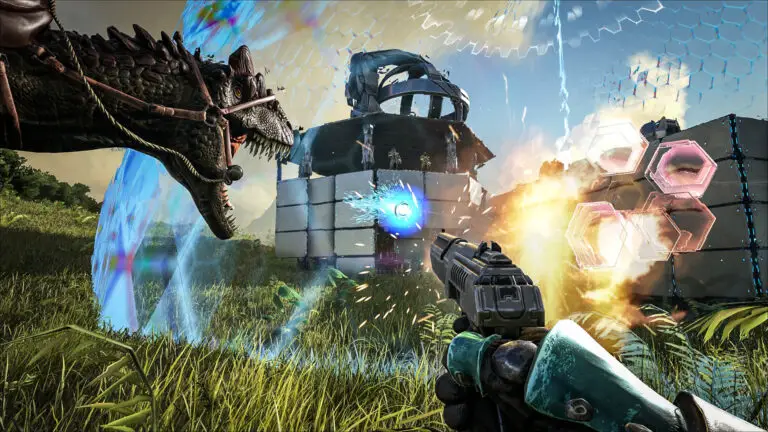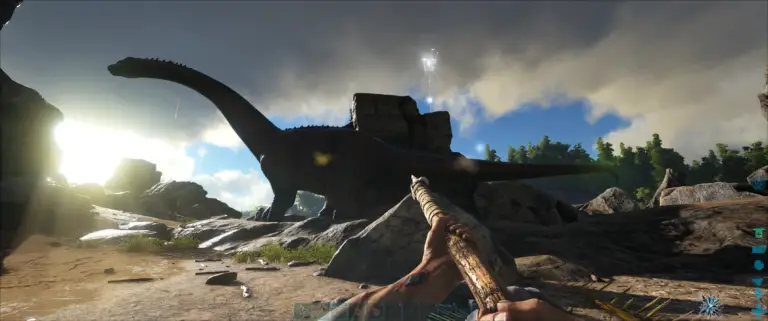Install Size
When considering the digital footprint of Palworld versus Ark: Survival Evolved, there’s a notable contrast in the required hard drive space. Palworld presents a more modest installation requirement, taking up just 19.2GB of hard drive space. This is relatively lean, especially when compared to the hefty size of many triple-A titles, making it a less daunting download and install for players.
In stark contrast, Ark: Survival Evolved demands a significant portion of digital real estate. The base game alone occupies a colossal 128GB, and that’s with only the first map accessible. For those who wish to delve into all six of the main story expansion maps, the game balloons to an immense 223GB. And for the completists who install every official map without any mods, the game consumes a staggering half-terabyte, making it one of the largest games in terms of install size.
The disparity in install sizes between the two games is significant, with Ark’s original Survival Evolved version requiring a substantial commitment of hard drive space that could be a deciding factor for players with limited storage capacity.

(Image credit: Studio Wildcard)
Performance
The performance of Palworld and Ark: Survival Evolved showcases the evolution of system demands and framerate capabilities in survival games. Ark is known for its intensive system requirements, challenging even the most advanced gaming setups to maintain high framerates at resolutions above 1440p. This is especially true when rendering large player-made structures.
Conversely, Palworld, while not the most optimized game, is significantly less demanding. A mid-range graphics card like the Geforce 2060 can achieve a mostly consistent 60fps at 1080p with max settings. Enabling DLSS and reducing detail to ‘high’ can push the framerate to 90fps. High-end machines can reach 120fps with settings maxed out.
Both games are scalable down to the Steam Deck, targeting a 30fps framerate. Palworld performs well at medium/low settings, whereas Ark requires further reductions in settings and resolution scaling.
| Palworld | Ark: Survival Evolved |
|---|---|
| 60fps at 1080p on Geforce 2060 (max settings) | Challenging to maintain high framerates on advanced systems |
| 90fps with DLSS and ‘high’ settings | Requires settings reduction for consistent performance |
| 120fps on high-end machines (max settings) | Struggles with large structures and high resolutions |
| Scalable to Steam Deck (30fps at medium/low settings) | Scalable to Steam Deck with significant settings reduction |

(Image credit: Pocketpair)
PvP
The player versus player (PvP) mechanics in Palworld and Ark: Survival Evolved offer distinct experiences that cater to different player preferences. Palworld launched without a PvP mode, focusing instead on cooperative gameplay for up to 32 players per server. This absence of PvP at the outset has contributed to its early success, as it provides a more relaxed environment that’s also well-suited for solo play.
In contrast, Ark is infamous for its intense and often unforgiving PvP experience. Public servers, which can host up to 70 players, are battlegrounds where newcomers can quickly become targets for capture, griefing, or forced recruitment by established player groups. The game’s mechanics, including resource gain and stats, are tailored to support this competitive MMO-lite structure, making solo play more challenging without adjustments to the game settings.
- Palworld launched without PvP, focusing on cooperative and solo play.
- Ark features notorious, hardcore PvP with a potential for griefing and base raiding.
- Ark’s public servers can host up to 70 players, fostering a competitive environment.
- Solo players in Ark may need to adjust game settings for a balanced experience.

(Image credit: Pocketpair)
Early Game Accessibility
Introducing new players to their worlds, Palworld and Ark: Survival Evolved take divergent paths. Palworld offers a more welcoming start, placing all players on a plateau reminiscent of “Breath Of The Wild.” This starting area is relatively safe, populated by mostly harmless creatures and abundant resources, providing a comfortable space for building and learning the game’s mechanics. A tutorial NPC is present to guide players through the basics, and a checklist of objectives helps to structure the early game experience.
Ark, however, can be less forgiving to newcomers. Players choose from various starting locations, some labeled as easier than others, but even these can be perilous with the chance of immediate danger from aggressive dinosaur spawns. Establishing a foothold often requires trial-and-error, and finding a safe spot to build a first shelter and place a sleeping bag for respawning can be a challenge.
The contrast in early game accessibility between the two games is clear, with Palworld’s gentle introduction standing in stark relief to the potential immediate threats and harsher learning curve of Ark.

(Image credit: Pocketpair)
Building Interface
The building interfaces of Palworld and Ark: Survival Evolved reflect their differing approaches to construction and resource management. In Ark, players must gather resources manually, craft them into building pieces, and transport these items to the construction site. This process can be cumbersome and time-consuming, often requiring multiple trips or the assistance of tamed dinosaurs to carry the heavy loads.
Palworld streamlines the building experience significantly. With a Palbox at the heart of your base, all basic construction resources stored within are accessible anywhere in your zone of control. This eliminates the need to physically carry materials, allowing for the placement of blueprints that automatically draw from your resource pool. The game also permits up to three bases, each with its own Pal population, and the construction process is further expedited by your tamed Pals who can assist with assembly.
This comparison highlights the ease of building in Palworld, offering a more user-friendly interface that reduces the friction of base construction, in contrast to the more involved and potentially laborious system in Ark.

(Image credit: Pocketpair)
Creature Taming
The process of creature taming in Palworld is reminiscent of the beloved Pokémon series. Players craft Pal Spheres at their base, engage creatures in combat to weaken them, and then attempt to capture them by hitting them with a sphere. Successful captures add the creatures to your team, allowing you to carry up to five Pals at a time and assign a workforce to your bases.
In contrast, Ark: Survival Evolved adopts a more intricate taming process that fits its MMO-lite style. Dinosaurs must be stunned, contained, and gradually tamed through a cycle of feeding and waiting. Once tamed, some dinosaurs can be ridden, provided you’ve crafted the appropriate saddle. This methodical approach is essential for larger battles in the game, including boss fights where players can bring a team of their strongest tamed creatures into the fray.
These contrasting taming mechanics highlight Palworld’s straightforward and engaging system against Ark’s more complex and time-intensive approach, offering different levels of depth and involvement to suit various player preferences.

(Image credit: Pocketpair)
Combat
Combat in Palworld and Ark: Survival Evolved presents players with distinct gameplay mechanics and styles. Palworld offers a more dynamic combat experience with a third-person perspective, featuring a reliable dodge roll, telegraphed enemy attacks, and a focus on ranged combat. Players can utilize bows and guns, as well as their Pals’ projectile moves, to engage foes from a distance while their summoned creatures share the brunt of the battle.
Ark’s combat is more traditional and can be messier, with a first-person perspective that emphasizes melee encounters. Dinosaurs typically rush players, leading to close-quarters combat where arrows can only do so much before resorting to melee attacks. As players progress and tame dinosaurs, ranged combat becomes more viable, but the overall experience is tailored to suit the game’s MMO-lite structure.
The combat systems in both games require players to manage limited stamina and resources, but the approach to fighting and the player’s role on the battlefield vary greatly between the two, offering unique challenges and strategies.

(Image credit: Studio Wildcard)
Conclusion
In conclusion, Palworld and Ark: Survival Evolved offer distinct takes on the survival game genre. Palworld simplifies many of the complexities found in Ark, making it more accessible for solo players and those new to the genre. Its streamlined building, creature taming, and combat systems allow for a smoother and faster-paced experience, albeit with currently fewer activities and goals beyond leveling up and defeating world bosses.
Ark, with its challenging survival elements and intense PvP, continues to captivate a large audience that appreciates its depth and the high stakes of its gameplay. Its demanding nature and the thrill of its competitive environment offer a unique experience that some Palworld players may eventually seek out, especially with the anticipation surrounding the upcoming release of Ark 2.
Both games have the potential to be all-consuming, each appealing to different player preferences and playstyles. Whether you’re looking for a gentler introduction to survival games or a deep, challenging experience, these games are poised to take up a significant amount of your time once they’ve drawn you in.

(Image credit: Pocketpair)












